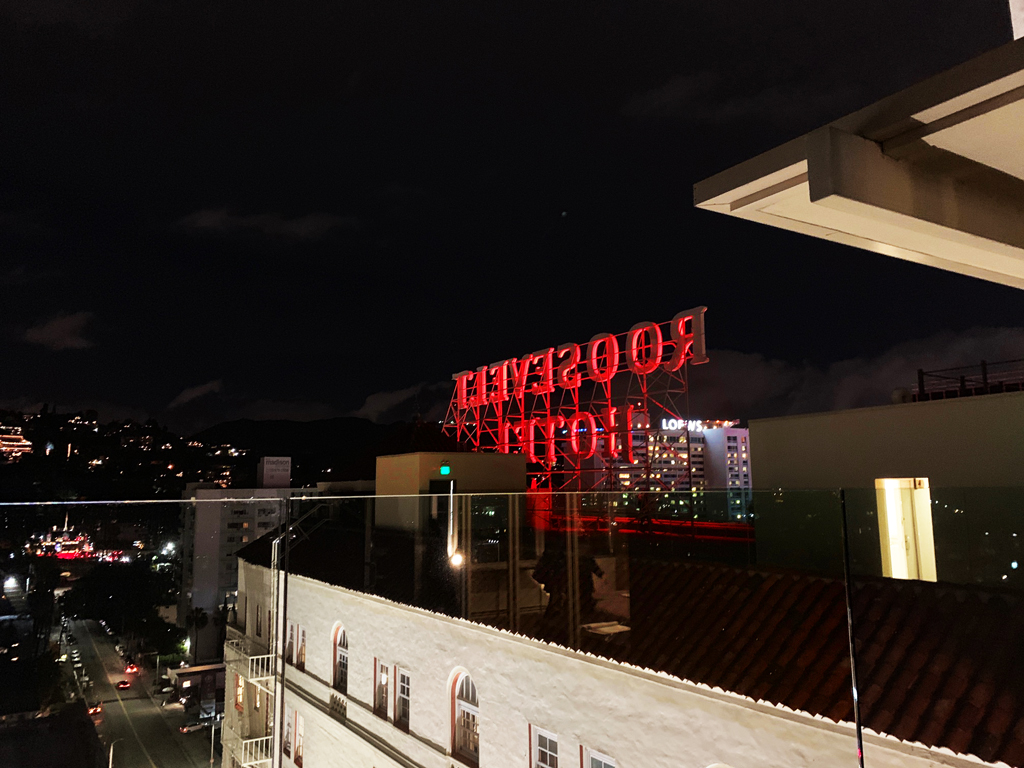[ad_1]
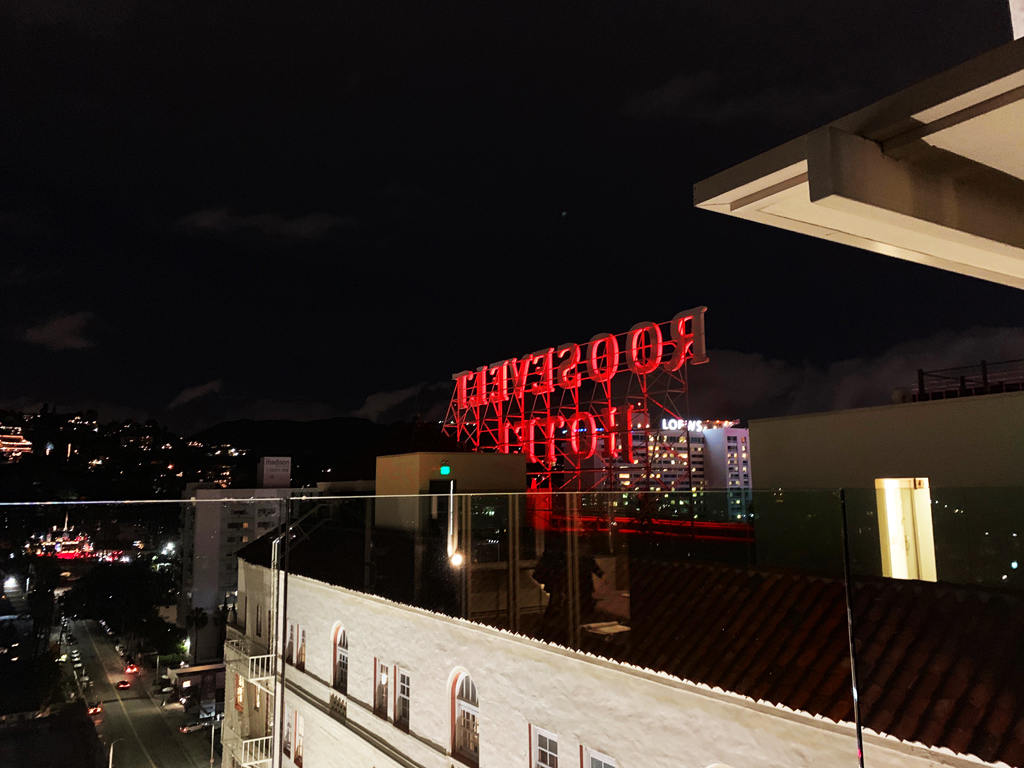
A view from the penthouse at the Roosevelt Hotel in Los Angeles, host to the Felix LA art fair.
ANDREW RUSSETH/ARTNEWS
At the first edition of the new art fair Felix LA, Rental Gallery is hawking T-shirts for art-world insiders designed by Kenny Schachter, with bestsellers including one with a Frieze-fairgoer who’s burst into flames and another with Yoko Ono and John Lennon superimposed with the faces of critics Jerry Saltz and Roberta Smith. A few hours into the opening on Thursday, stock was already running low on another for Mary Boone—printed with the words “FREE MARY” in reference to the two-and-a-half-year prison sentence just issued to the dealer for tax fraud. Boone’s image appears behind bars, in a mini dress with prison stripes. It is crass and sexist—yet darkly and deliciously funny too.
“It’s nice if you know and care about Mary,” Rental Gallery’s Joel Mesler said. “Kenny and I, we want to bring cheer.” As fairgoers came in off the pool deck through a sliding-glass door, one noted the overwhelming scent of French fries. Someone from the gallery had just ordered room service.
A certain free-flowing and not-so-serious vibe abounds at Felix LA, a fair at the Hollywood Roosevelt Hotel that sprang from the mind of Dean Valentine, a former TV executive and top collector in town. His goals for the fair (which launched on Valentine’s Day) were two-fold: to shake up the monotony of fairs taking place in windowless convention centers, and to ease the financial burden that fairs impose on galleries. In lieu of high prices for booths, Felix participants got hotel rooms and suites ranging for fees ranging from $4,000 for the smallest up to $10,000 for a penthouse. With Al and Mills Morán, gallerists in West Hollywood, Valentine invited 41 galleries to set up shop. The organizers “didn’t give me a choice,” said Mesler. “They said if I don’t do it, they’re going to kick me out of the art world.”
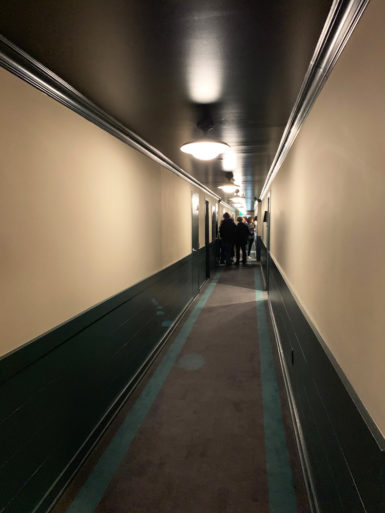
A hallway on the 11th floor of the Roosevelt Hotel.
ANDREW RUSSETH/ARTNEWS
The fair in the Roosevelt—a site of Hollywood debauchery and lore not far from where Spider-Man and Elvis impersonators work the Walk of Fame—is free and open to the public. As a result, an epic line had formed in the lobby leading up to the elevators. According to hotel security, the galleries on the 11th floor had reached capacity.
“If you go down to the cabanas, it’s not as packed,” a publicist texted me, in reference to rooms that line the perimeter of the hotel’s iconic David Hockney-painted pool. Despite the misty wake of the morning’s torrential rains, an outdoor bar buzzed with people ordering drinks and smoking cigarettes. Gallerists kept the sliding-glass doors for their patios open, letting visitors roam from room to room between the pool deck and the inside of the hotel.
Gabrielle Giattino, the owner of Bureau gallery in New York, said she preferred the poolside cabanas over the suites upstairs. “I’m not going to come all the way to L.A. and not be by the pool,” she said. She came to L.A. to “connect with a broader range of clients”—who might soon include Brad Pitt, who passed through earlier and expressed an interest in works by Matt Hoyt. His fossil-like sculptures were displayed on the nightstands that served as plinths, with most of the other furniture gone. “Is there meant to be a bed in here?” a fairgoer asked.
“The hotel let us play,” Al Morán explained to me later. Exhibitors could choose their furniture layout “à la carte” from digital renderings of the rooms, and unwanted objects could be whisked into storage. Was that a lot of extra work? “A fuckload,” Morán said. “But the hotel made it look effortless.”
For the L.A. gallery Château Shatto, a bathroom served as a shop for artist merchandise, like sweatshirts by Parker Ito. For Baik + Khneysser, another local gallery, a glass shower stall was ideal for Mella Jaarsma’s hanging sculptural nudes. Someone from the gallery Brennan & Griffin turned off the bathroom lights to display Pooneh Maghazehe’s LED-abetted clay and cardboard sculptures in an appropriately dark space. The set-up was a welcome alternative to more traditional fairs, Katherine Brennan said. “People are sick of the bigger and bigger white-box gallery space and how money has become such a big factor,” she said. “The whole vibe is incredibly refreshing.”
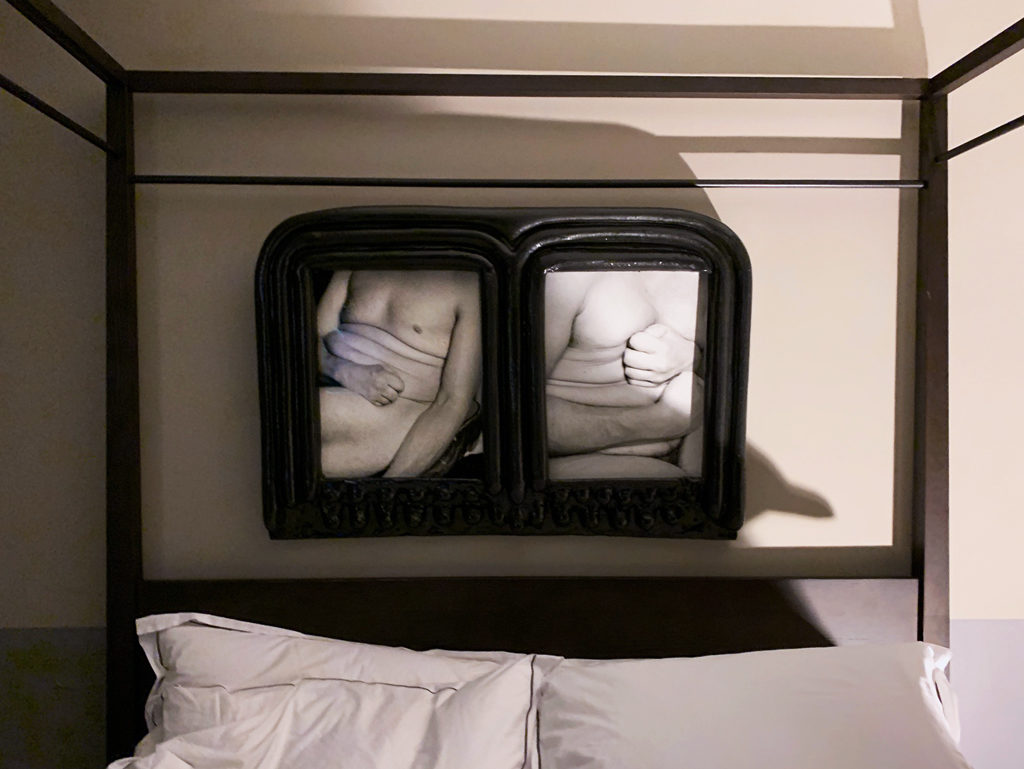
Work by Dan Finsel above a bed in Michael Benevento’s room.
ANDREW RUSSETH/ARTNEWS
Claire Warner of Chicago’s Volume Gallery, whose offerings included textile-based pieces by Tanya Aguiñiga and Christy Matson, agreed. “Today at fairs, collectors just go through, take a picture, and leave,” she said, whereas at Felix visitors were more apt to slow down and engage in conversation. She credited the atmosphere to the fair’s founders. “Al, Mills, and Dean are part of the community here. They know what conversations need to happen and the pace of the market.”
The lobby, meanwhile, was a scene. In the dim mood lighting of the faux Spanish mission-style atrium, people sprawled on black sofas while ordering burgers and cocktails. It was hard to tell who was there on official art-world business and who was there just to have a good time.
“Fairs are becoming more exclusive and catering to VIPs, which is a good, because they’re who buys the work,” said Andy Brown of Marc Selwyn gallery. “But this is a great bridge, an interesting rethinking of that model.” While the Beverly Hills–based gallery was showing drawings by Allen Ruppersberg at Frieze, its Felix presentation was a table in the lobby with “Jennifer Aniston’s Used Book Sale,” a solo project by L.A.-based ceramic artist Kristen Morgin. She made a sort of portrait of the actress by imagining the books she would own, meticulously sculpting and painting them into convincing dog-eared copies covered with peeling price stickers. The works, 50 or so, were individually priced from $3,800 to $7,000 and selling “really well,” Brown said. “These are relatively affordable pieces in the grand scheme of things, and definitely a smaller project than we would normally do at a fair like Frieze, the Armory, or in Miami. We were more thinking this would be fun.”
Also fun: While Culver City gallerist Susanne Vielmetter was manning her booth full works by Kim Dingle at Frieze, she handed control of her room at Felix to artist and illustrators Esther Pearl Watson and Mark Todd, who erected their Record Store From Outer Space and stocked it with strobe lights and handmade zines. The Santa Monica gallery Five Car Garage turned a reception area into a potion shop where L, a local artist and practicing witch, gifted me a miniature cosmic love potion with googly eyes for attraction, a penny for luck, and candy hearts suspended in clear mineral oil.
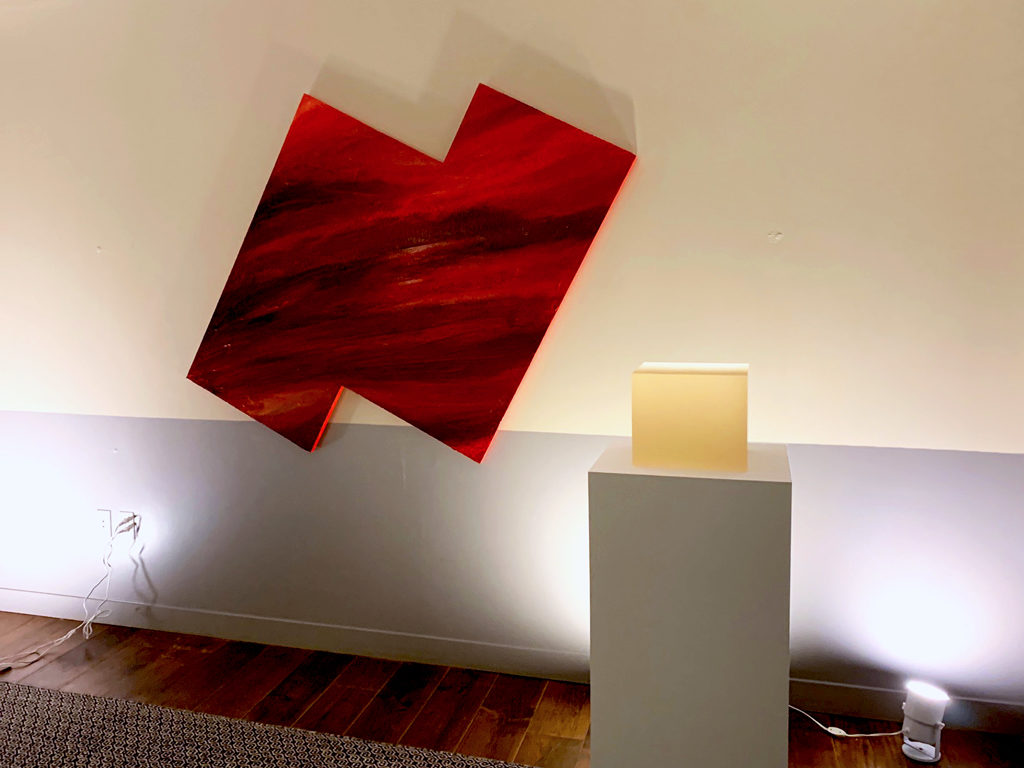
A shaped painting by Alteronce Gumby, left, and a yellow cube by Peter Alexander at Los Angeles’s Parrasch Heijnen Gallery.
ANDREW RUSSETH/ARTNEWS
The scene at Parrasch Heijnen, where works ranged from $3,500 to $65,000, felt like a living room, with visitors sitting on the back of a couch admiring a Peter Alexander cube in warm yellowing lighting. “Conversations are nice and engaging when you’re not in a huge echo chamber—and you can order room service,” Franklin Parrasch said, as a tray of food was delivered. He did note that the light crowds in the hallways were not necessarily a good sign. “The elevator is a quasi-disaster,” he said of a scrum that left some annoyed collectors stuck in the lobby.
“Everything feels more intimate,” said David Daniels of the gallery Morán Morán. The sentiment was echoed by the sounds of loud lovemaking drifting down the hallway. L.A. gallerist Michael Benevento’s project room had black-and-white closeup self-portraits of Dan Finsel’s body alongside a video piece by Kaari Upson, in which the artist, adorned with prosthetic vulva and breasts, was gyrating over the camera while moaning a continuous string of “oh yeahs.” Benevento was wearing a tuxedo as he reclined on the four-poster bed, the optics of which left some visitors confused as to whether they had walked into a performance. The tux was partly inspired by a scene from The Shining, Benevento explained. The rhythm of Upson’s voice, especially compared to other video works, proved quite soothing. As Benevento made use of his hotel bed and lay down, he touched on the beauty of Felix LA—the freedom to make oneself comfortable.
[ad_2]
Source link

